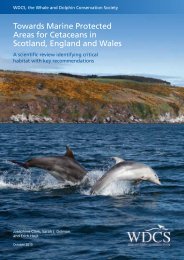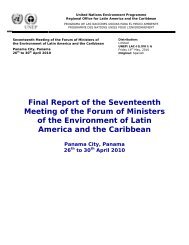Sea Turtle Recovery Action Plan for Barbados - WIDECAST
Sea Turtle Recovery Action Plan for Barbados - WIDECAST
Sea Turtle Recovery Action Plan for Barbados - WIDECAST
You also want an ePaper? Increase the reach of your titles
YUMPU automatically turns print PDFs into web optimized ePapers that Google loves.
CEP Technical Report No. 12<br />
sea turtle conservation. The major role of the CCPU in terms of sea turtle recovery lies in<br />
continuing to monitor the beach and nearshore environment, and in making recommendations on<br />
how these areas can best be conserved. The objectives of the second phase of the Coastal<br />
Conservation Project are to identify major sources of environmental stress on the coastal zone<br />
and to suggest methods of mitigation. An institutional strengthening project will review existing<br />
laws pertaining to the coastal zone and the present infrastructure <strong>for</strong> coastal zone management.<br />
Recommendations<br />
- In<strong>for</strong>mation on sea turtle nesting activity at specific locations should be made available<br />
to the CCPU upon request to Bellairs Research Institute, and passed to the Town <strong>Plan</strong>ning<br />
Department as part of the recommendations of the CCPU.<br />
- Wherever possible, vegetation should be used in preference to boulder placement <strong>for</strong><br />
beach stabilization at turtle nesting beaches. Furthermore, the use of vegetation should be<br />
recommended in preference to physical structures in order to delineate seaward boundaries of<br />
properties adjacent to beaches.<br />
4.612 Town <strong>Plan</strong>ning Department (TPD)<br />
The Town <strong>Plan</strong>ning Department (TPD) has the responsibility of ensuring that the land<br />
resources of <strong>Barbados</strong> are used efficiently <strong>for</strong> the wide range of demands made upon them.<br />
Since <strong>Barbados</strong> is densely populated and also supports a large tourist industry, pressure to build<br />
along the coastal zone is particularly intense. However, it is extremely important that the TPD<br />
take into consideration the long term effects of development on the environment. It was partly<br />
<strong>for</strong> this advisory function that the CCPU was established in 1983. The TPD takes the advice of<br />
the CCPU into account when deciding whether to grant planning permission <strong>for</strong> construction in<br />
the coastal zone. Nonetheless, at his discretion, the Minister of Housing and Lands can over-ride<br />
a decision of the TPD, such as when the economic advantages to <strong>Barbados</strong> of developing a<br />
particular site appear to outweigh potential environmental degradation.<br />
Recommendations<br />
- The TPD should take into consideration the level of sea turtle nesting activity at sites<br />
where planning permission is being sought, particularly in regard to the positioning of seaward<br />
boundary walls and fences. If the CCPU has recommended the use of beach vegetation in place<br />
of a seaward boundary wall, this should become a condition of planning permission.<br />
- The TPD should advise architects, landscape architects and developers when the<br />
property they are designing/developing is adjacent to a sea turtle nesting beach.<br />
- The TPD should consider restricting the types of lights permitted on all new<br />
developments adjacent to beaches along the west, south and east coasts. There is recent evidence<br />
that low pressure sodium (LPS) lighting, emitting light in the range of 590 nm, is less attractive<br />
to sea turtle hatchlings that full spectrum white light (Witherington, 1990).<br />
Page 36

















